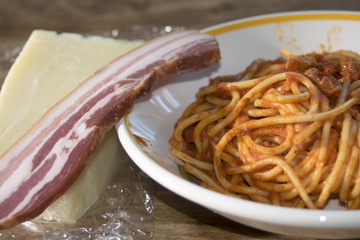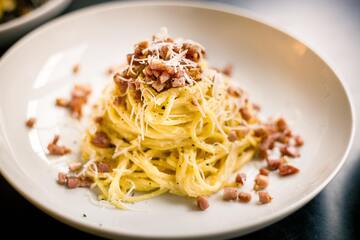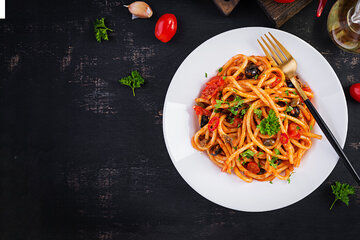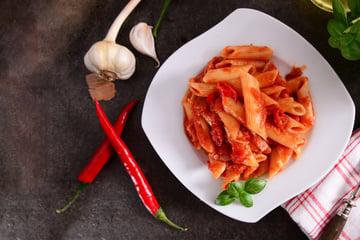National Pizza Day: How to make homemade pizza dough
It's National Pizza Day! And in honor, we're tossing up our favorite homemade pizza dough recipe.
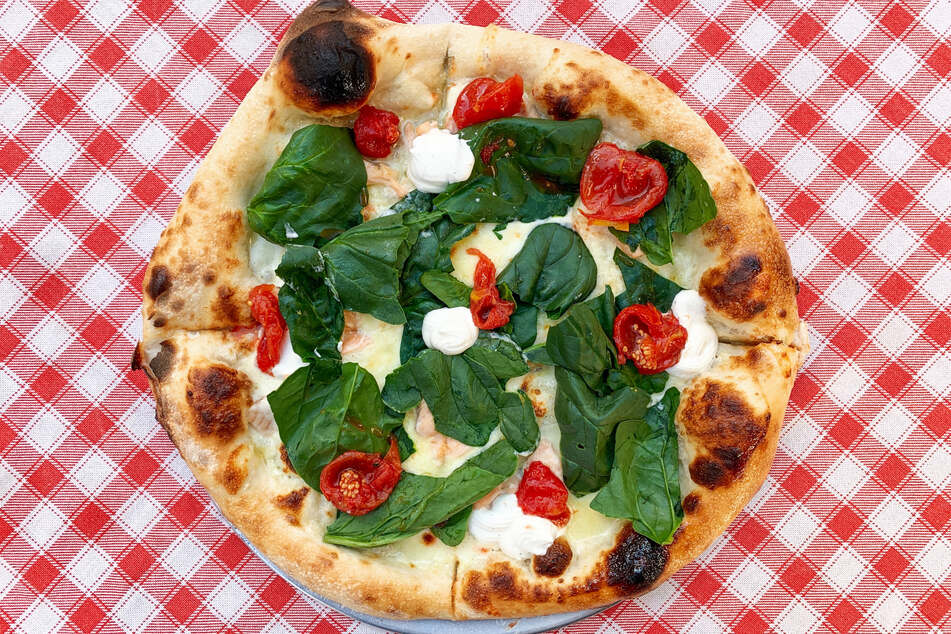
There's nothing that hasn't already been said about pizza. It is the god of all foods, the bees in our bonnets, our first and our last, the numero uno of all foods, and for good reason.
Getting that perfect blend between bread, sauce, cheese, and toppings is a delicate and contentious topic and becomes even more delicate when we try to make it at home.
Pizza is insanely diverse and can come in many forms, but the best is always the original. Getting that crispy bread right, with fresh ingredients, is key but also the hardest part.
Let's be real, pizza is the ultimate food, so this is a biggie! TAG24 is here to take you through everything you need to know about homemade pizza dough.
Here's how to make pizza at home. Let's go!
What's the best pizza in the world?
The debate between different pizzas has, forever, been a confusing mess of opinions. There's a simple and constantly overlooked fact in this debate, and yes, we're going to go there: Pizza is from Italy, and the best Italian pizza is found in either Naples or Rome.
Roman pizza is characterized by a thin and crunchy crust that's extraordinarily tasty and takes on the smokey flavor of the pizza oven. At its best, it's like biting into a chip, crunchy and flaky, and often made simply, with very few toppings. The best way to eat a Roman pizza is "Bianca," with nothing but some fresh buffalo mozzarella, cherry tomatoes, and fresh basil.
Neopolitan pizza is very different, characterized by a fluffy outer rim that rises significantly and becomes almost like a puffed-up cloud. It's yeasty and doughy and incredibly delicious and something usually adorned with more complicated toppings. Make it a pizza rossa, have anchovies on there, maybe a quattro formaggi, whatever you want.
There's no definitive "best pizza", of course, because we all have our own tastes and preferences. At the risk of breaking my own rule, though, Roman pizza is definitely the best. Deal with it!
Pizza bianca vs. pizza rossa: What's the difference?
You might have noticed I mentioned pizza bianca and pizza rossa in the previous few paragraphs. Don't worry, it's pretty straightforward: Pizza Bianca translates to "white pizza" and is pizza without a tomato sauce base, and pizza rossa translates to "red pizza" and is pizza with a tomato sauce base.
There is something incredibly fresh and delicious about taking beautifully made pizza dough and keeping it as simple as possible. The tomato sauce often overpowers many of the delicate flavors often seated atop a pizza (buffalo mozzarella, for example), so the pizza bianca is a great way to tone it all down. On the other hand, pizza rossa offers a rich and delicious classic pizza experience.
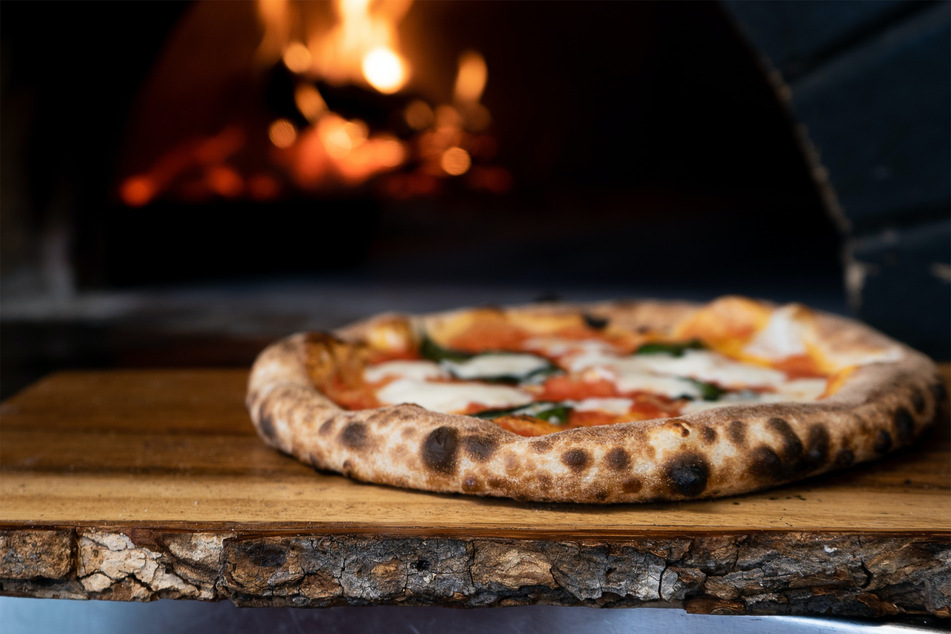
How to make homemade pizza dough: Recipe
Making pizza is a tough thing to do, especially if you want the dough to be soft, fluffy, and delicious. The trick is going in extremely hot, even if you're using an oven, and using the right equipment. Let's start with the latter. What equipment do you need to make a pizza at home, assuming you're not using a pizza oven? Well, it's time to find out!
Here's what you need to make homemade pizza:
- Measuring jugs
- Large flat surface that can be dusted with flour
- Pizza stone
- An oven capable of being heated to at least 400°F
- Knife
- Pizza peel
The most important thing to have when cooking a pizza (if you don't have a pizza oven) is a circular pizza stone and an oven that can preferably reach 475-500°F.
Pizza dough recipe | Ingredients
Pizza dough is not the easiest nor the quickest thing to make. You need to allow for a decently long fermentation process. That means allowing a minimum of 16, but preferably 24–48 hours of fermentation time, that means proofing them properly, that means careful and thorough kneading, and that means showing your pizza dough the love and affection it deserves.
A quick note: This recipe makes around four pizzas, but feel free to add and subtract quantities based on how many you are making, just take care to keep the ratios the same.
Here are the ingredients for homemade pizza dough:
- Type 00 Flour, 35 oz
- Fresh yeast
- Water, 3 cups
- Salt, 2 tsp (to taste)
- Sugar, 2 tsp
It is important to get the ratios accurate here and to follow the instructions carefully so that your yeast activates.
Pizza dough recipe | Instructions
This is where things get long and complicated. How do you make homemade pizza? Well, with a lot of patience and (probably) many practice rounds and failed attempts. The trick is getting the kneading right, activating that yeast, and allowing it to ferment and proof properly. Let's get on with things.
Here's how to make pizza at home
Step 1: Use your hands or a spoon to mix together the water and salt in a large bowl. You want to dissolve the salt into the water so that it is pre-seasoned and therefore salts the dough as you go.
Step 2: Mix in a little bit of the flour (about 1 handful) into the water, getting dirty with your hands and mixing thoroughly. Once combined, add another fistful and repeat the process.
Step 3: Add the yeast, using your fingers to quickly combine it into the water. Then, add the sugar (which will hopefully "activate" the yeast, causing it to froth up a bit), doing the same thing, followed by the rest of the flour (bit by bit).
Step 4: As you stir in these ingredients, turn the bowl and try to mix from the bottom to the top as much as you can while folding everything away from the sides.
Step 5: Continue to work in the flour until it is relatively combined, then add your olive oil and fold it all together until it is one giant ball.
Step 6: Let the dough sit for 5–10 minutes covered in a cloth, before taking it out again and working the dough repeatedly.
What you need to do here is "knead" the dough. This is a process that is more or less impossible to describe in writing, so here's a quick and easy video explainer!
Step 7: Repeat this kneading process around 3–4 times with ten-minute intervals. You want it to reach the right consistency: a little bit bouncy and incredibly smooth all over.
Step 8: Leave this dough covered, in the bowl, with cling foil and a tea towel over the top (make sure that it is airtight), for at least 16 hours, preferably between 24 and 48. This should be done in a cool space.
Step 9: Give your dough baby a slap and dust your counter off with a bit of flour. Divide it into however many pieces you want (so, however many pizzas you want to make) and then roll them again into separate balls.
Step 10: Allow to proof at room temperature for around 4 hours (covered). After this, shape your dough using your hands or a rolling pin so that it is flat and circular (on a flour-dusted surface). Allow for a slightly thicker rim, and make sure there are no tears.
Step 11: Place your pizza stone into your oven and preheat it to the maximum setting (preferably around 500°F). You should not put the pizza in there before it has reached the right temperature.
Step 12: Adorn your pizza with all the toppings you want while you wait for the oven to heat up.
Step 13: Slide your pizza onto your peel and then straight on the pizza stone. It shouldn't take very long (5-10 minutes, sometimes less than 5), so watch it and take it out once it looks puffed up, a little charred, and, well, like a pizza!
Enjoy your pizza with a nice glass of red wine (or something more kid-friendly)! Make sure to only cook one pizza at a time and to give a little bit of time between them to help maintain the heat of the pizza stone.
How to make homemade pizza sauce
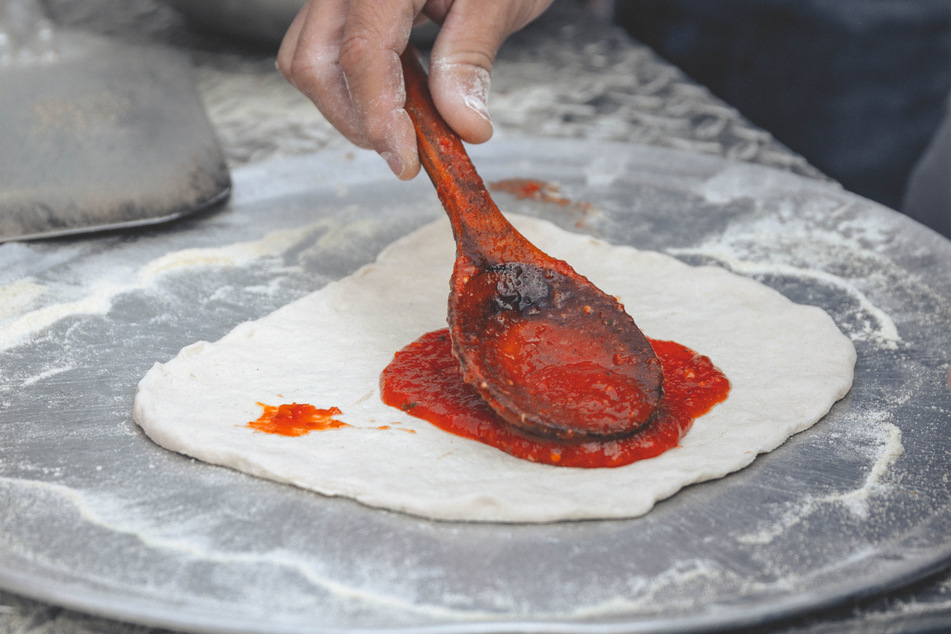
Here are the three most important things to make sure of when you're making tomato sauce for pizza: Don't cook it, keep it extremely simple, and use high-quality, delicious, fresh ingredients. If you cook the tomato, then you will be cooking it twice, once on the stove and once in the oven, and the flavor will completely change (for the worse).
On top of that, the best tomato sauce for pizza does not require a blender. You should use high-quality canned tomatoes, yes, but they should be whole tomatoes that you can then crush by hand. Indeed, you're going to get dirty, but the coarseness of hand-crushed tomato is absolutely perfect for a pizza and will add an extra texture.
Please note: We won't add proportions here as it is dependent on how many pizzas you are making and how much sauce you want to put on each. Make a value judgment and remember the golden rule - taste for seasoning every step of the way!
Homemade tomato pizza sauce | Ingredients
- Canned tomatoes
- Basil
- Salt
- Pepper
- Extra virgin olive oil
Homemade tomato pizza sauce | Instructions
This is one of the quickest and simplest things you will ever do. Get a large metal bowl and fill it with your canned tomatoes. Season generously with salt and pepper and a decent quantity of olive oil. With your hands, reach in and crush the tomatoes, mixing thoroughly and squeezing out all the juices until you have a pulpy and thick sauce. Add your basil and stir it in.
It's all about the quality. Get the best canned tomatoes from a proper Italian brand, get high-quality extra virgin olive oil, and don't be afraid to get dirty. Don't go blending the sauce, use your hands.
Best homemade pizza toppings
The key to a good pizza topping is keeping it simple and keeping it fresh. It is better to use one or two incredibly high-quality and flavorful ingredients than ten cheap and cheerful alternatives. Of course, pizza is a blank canvas that you can adorn with whatever flavors and colors you want, but these are the best toppings you can ever hope for.
Here are the best pizzas to make at home:
- Pizza Napoli: Tomato base, mozzarella, anchovies.
- Pizza Quattro Formaggi: Tomato base (optional), pecorino romano, ricotta, gorgonzola, mozzarella.
- Pizza Capricciosa: Tomato base, ham, mushrooms, olives, artichoke, egg.
- Pizza Pachino: Buffalo mozzarella, cherry tomatoes, basil (no sauce, Bianca).
- Pizza Diavola: Tomato base, mozzarella, spicy Italian salami, chili oil.
Make whatever pizza you want! These are some of the best kinds of pizza you can get, especially if you focus on the quality of the ingredients. It's not something you need to be careful with, though.
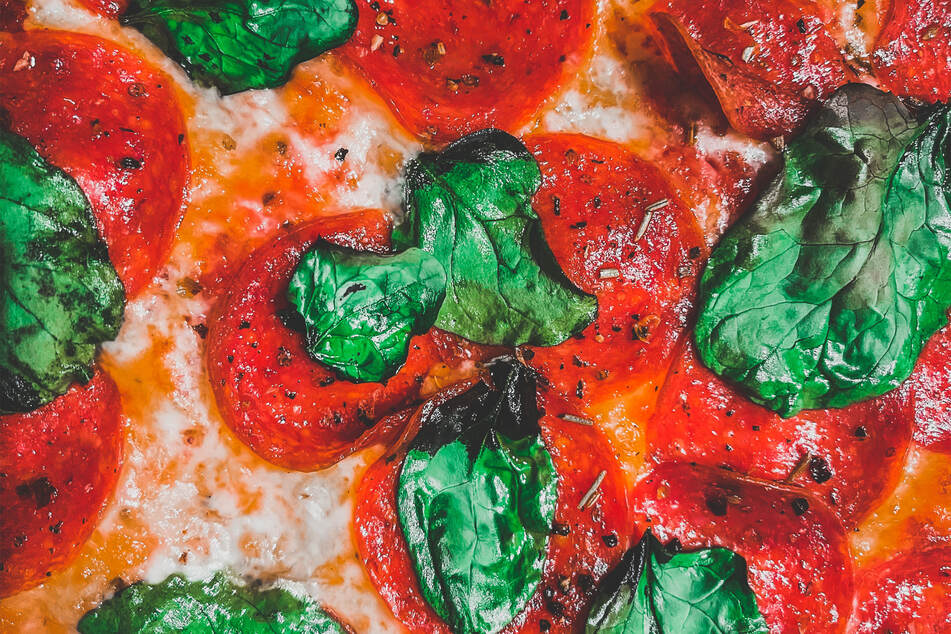
Homemade pizza crusts can be good, you just need the know-how!
Let's be real: Most homemade pizza isn't going to be nearly as good as the stuff you get at an authentic Italian restaurant. It can still be good, though, and if you have the space and money, then a pizza oven ain't going to be a bad investment (you can make other foods in there, too!). You just need to know how to do it.
The trick to good pizza is getting that homemade dough perfect, rolling it out properly, and cooking it the right way. If you get those basics right, then it doesn't matter what you put on top, it's going to be a great pizza!
Cover photo: Unsplash/Anastasiia Chepinska

